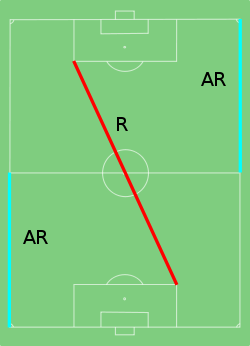- Diagonal system of control
-
The diagonal system of control is the system of positioning used by match officials (referees and assistant referees) in association football (soccer). This allows the referee to officiate in a fluid motion without needing to turn his back to the play, stop, and then turn around sharply.
Description
The diagonal system of control (DSC) can best be described by outlining the basic duties of the three match officials:
First, the two assistant referees are instructed by the referee to each patrol half of a single touchline on opposite sides of the field. For example, on a field running north-south, one assistant referee (AR) would run on the eastern touchline from the north goal line to the halfway line, while the other assistant referee would run on the western touchline from the south goal line to the halfway line. In general, the assistant referees' duties would be to indicate (using their flags): when an offside offence has occurred in their half, when a ball has left the pitch, and if a foul has been executed out of the view of the referee (typically in their quadrant of the field). Generally, the ARs will position themselves in line with either the second to last opponent or the ball — whichever is closer to the goal line — in order to better judge offside infractions. However, the assistant referee will have specific positioning with respect to corner kicks, penalty kicks, and throw-ins.
Quadrant 1 Quadrant 2 Referee Assistant Assistant Referee Quadrant 3 Quadrant 4 The referee patrols the length of the field in order to cover the ground not covered by his two assistants, generally running in a diagonal pattern from the southeast quadrant of the field towards the northwest quadrant; hence the term "diagonal system of control". Note that this pattern is not a specific route but a general guideline that should be modified to the style of play, nature of the game, the location of play at a given time, etc. In some cases the referee may even exit the field if it aids in his decision making ability. The main idea is that the referee and assistants using the DSC should be able to position themselves quickly and easily to observe the important aspects of play (offside, ball in or out of play, goal-scoring opportunities, challenges for the ball) from multiple angles with multiple sets of eyes.
Note that the description above refers to a left diagonal system of control, known as "running a left" or "standard diagonal". If, before the match, the center referee on this field decides to run from southwest to northeast, then the assistants must position themselves accordingly and the result will be a right diagonal system of control, otherwise referred to as "running a right" or "reverse diagonal".
In international matches the left-wing diagonal shown above has been universal since the 1960s. It is now predominant across the world although a minority of referees in England still run the opposite diagonal and a very small number switch diagonal at half-time. The latter approach was mandatory in the Football League until 1974 but since officials have had the choice most have opted to stick with the same diagonal throughout a game.
Its implementation as a standard practice for referees is attributed to Sir Stanley Rous, former referee and President of FIFA from 1961 to 1974.[1]
References
- ^ Rewriting the Laws of the Game (19 June 1997), also mention of the diagonal system of control for referees: FIFA.com website.
Categories:- Laws of association football
- Sports officiating
Wikimedia Foundation. 2010.

